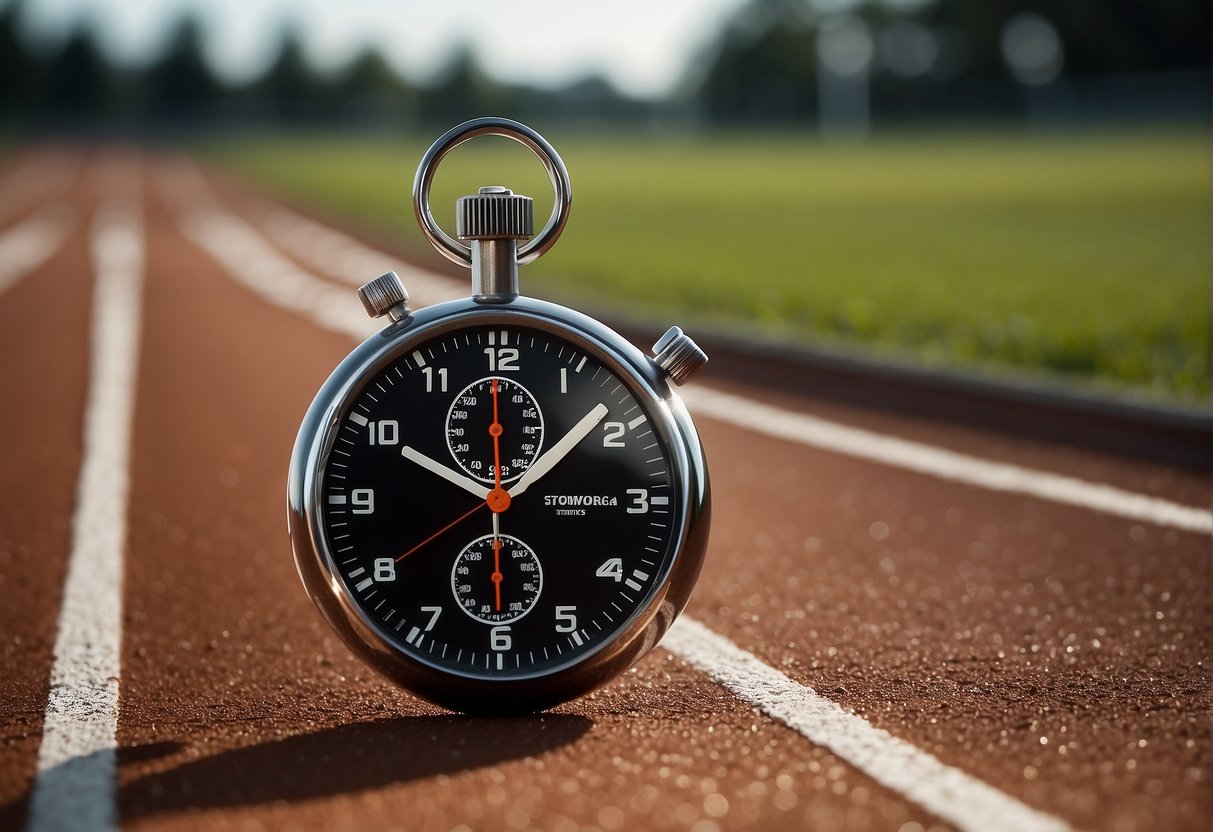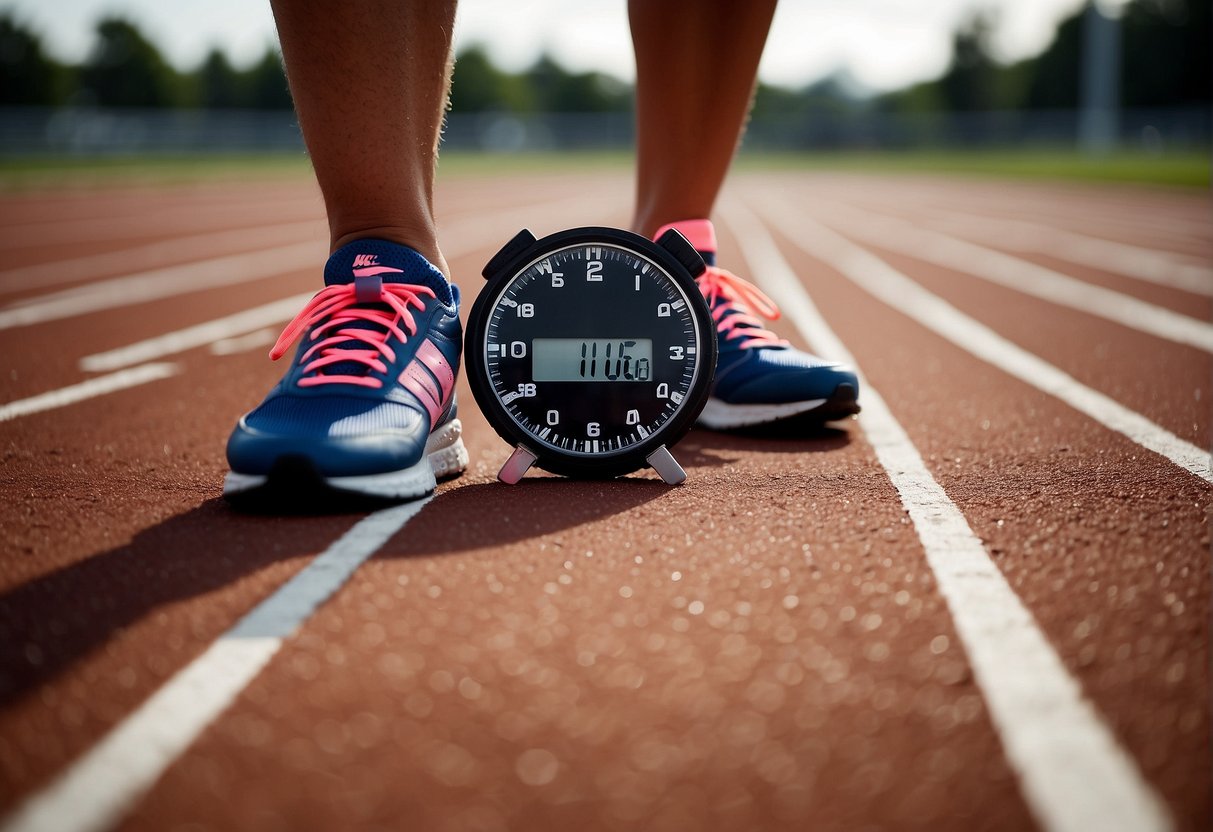Assessing the quality of a 12-minute mile time can vary depending on personal fitness levels, goals, and the context of the running. For a new runner or someone just getting into fitness, achieving a mile within this time frame is a solid accomplishment. It indicates that you can maintain a consistent pace and build a foundation for cardiovascular fitness. While it may not set records, a 12-minute mile indicates that you’re on the right track toward improving your endurance and speed.

It’s important to remember that running is a personal journey, and improvements are relative to your starting point. If your initial mile took longer than 12 minutes, trimming down to this time is evidence of progress. Moreover, consistent training often leads to faster times and improved health outcomes. Regular physical activity like running contributes to better aerobic fitness in children and adults, an essential component of overall well-being.
Your goals should be tailored to your evaluation of what constitutes a ‘good’ mile time. If you’re running for general health, a 12-minute mile can be perfectly adequate. However, if you have competitive ambitions or specific fitness targets, you might view this time as a benchmark to surpass. With proper training, most individuals can expect to improve cardiorespiratory fitness and see reductions in their mile time. Patience and persistence are key – running is as much a mental challenge as a physical one.
Quick Navigation
Understanding the 12-Minute Mile

Understanding your pace is key to tracking your progress when starting as a runner or setting personal goals. Assessing whether a 12-minute mile is a good time for you begins with defining what it means and how it compares to average mile times.
Defining a 12 Minute Mile
A 12-minute mile refers to completing a mile in exactly 12 minutes. As a measure of speed, this pace translates to 5 miles per hour (mph). For beginners or those running for fitness rather than competition, a 12-minute mile can be a reasonable and attainable pace. Achieving this mile pace means maintaining a consistent running speed equivalent to a moderate jog for most people.
- Pace per Mile: 12 minutes
- Speed: 5 mph
Comparing Average Mile Times
Many factors, including age, sex, fitness level, and experience, can influence your average mile pace. Generally, a good time for running a mile varies by individual. The world records for the fastest mile times stand at 3:43.13 for men and 4:12.33 for women, showcasing the upper echelon of speed and athleticism. However, for many recreational runners, maintaining a pace that falls between a 10 to 15-minute mile is within the realm of average mile times.
- Fast: Under 8 minutes
- Average: 10 to 15 minutes
- Slow: Over 15 minutes
Comparatively, you’re within a widespread average running speed if you’re running a mile in 12 minutes. Though not incredibly fast, it’s a good time for many casual runners and signifies a consistent, moderate level of fitness. Remember, individual goals vary, and consistent improvement over time shows progress.
Health Benefits of Running

Regularly running a 12-minute mile can positively impact physical fitness and promote a healthier lifestyle. Consistent practice can improve various aspects of health.
Cardiovascular Fitness
Running is an excellent aerobic activity that strengthens your heart and improves your circulatory system. Engaging in this form of aerobic exercise can increase your cardiovascular endurance, making your heart more efficient at pumping blood and delivering oxygen to your cells.
Muscle Strength and Endurance
While the focus may be on the cardiovascular benefits, running also builds muscle strength. Your leg muscles, in particular, will develop increased endurance, allowing you to run longer distances without fatigue. Over time, as your fitness level rises, you’ll notice the strengthening of your quadriceps, hamstrings, glutes, and calves.
Weight Management
Running is a powerful tool for weight management as it helps you burn calories and reduce body fat. A consistent running routine will help maintain a healthy body composition due to the high energy expenditure of this aerobic exercise. Even at a pace of a 12-minute mile, you engage in moderate aerobic fitness activity that can contribute to a caloric deficit and weight loss.
Running Techniques and Training

Improving your running performance and achieving a 12-minute mile requires attention to detail in various training aspects. Ensuring proper running form, incorporating interval and strength training, and adequate rest can help enhance your running economy and endurance.
Form and Posture
Your running form is crucial to your performance and efficiency. Aim to maintain a relaxed posture with a slight forward lean, keeping your head up and your gaze forward. Your arms should swing naturally with elbows bent at a 90-degree angle. Short, quick strides with feet landing under your center of gravity contribute to better-running economy and reduced risk of injury.
Interval Training and Speedwork
To increase your speed and endurance, incorporate interval training into your routine. Interval training involves alternating periods of intense effort with recovery. For example, after a warm-up, run at a faster pace for one minute, then two minutes at an easier pace to recover. Repeat this cycle for a given number of sets. Speedwork, like 400-meter repeats, helps you get accustomed to faster paces and improves your fitness.
Strength Training and Flexibility
Include strength training in your weekly schedule. Exercises focusing on your core, quads, hamstrings, and calves will support your running form and reduce the risk of injury. Don’t neglect flexibility work; consistent stretching after your runs can enhance muscle recovery and flexibility, contributing to a smoother stride.
Rest and Recovery
Rest and recovery are as important as the workouts themselves. Schedule at least one day per week without running to allow your body to recover. During your recovery days, consider low-impact activities like yoga or swimming. Ensure you get sufficient sleep, essential for muscle repair and overall performance.
Adhering to a training plan that balances these elements tailored to your experience and goals will guide your progress toward achieving a comfortable and efficient 12-minute mile. Remember to adjust your training pace in response to how your body feels to prevent overtraining and injuries.
Running Gear and Equipment

The right gear can make a significant difference in your running performance and comfort. Your selection of running shoes, clothing, and accessories should cater to your individual needs. Additionally, harnessing modern technology and apps can enhance your running experience.
Selecting Running Shoes
Choosing the right pair of running shoes is paramount for comfort and injury prevention. Look for shoes that match your arch type—flat, neutral, or high—and consider the running you’ll be doing. Trail running requires more robust, grippy soles. Whereas road running is best with cushioned, lightweight shoes. Ensure a proper fit by trying them in-store and opting for brands known for their quality.
Clothing and Accessories
Your running attire should support your activity without causing distraction or discomfort. Wear moisture-wicking fabrics to keep you dry, and layer clothing to manage body temperature. Reflective gear is essential for visibility if you run early in the morning or late at night. Consider accessories like hydration packs or belts, especially for longer distances, to maintain your endurance and hydration levels.
Using Technology and Apps
Incorporating technology can provide you with detailed insights into your runs. Use GPS watches to track distance and pace and heart rate monitors to gauge your effort level. Running apps can offer training plans, run tracking, and even virtual coaching. Linking these tools to your running routine can motivate you and provide feedback to improve your 12-minute mile.
Psychology of Running

In the context of a 12 minute mile, understanding the psychological aspects of running can enhance your performance and satisfaction. This discussion revolves around goal-setting, mental fortitude, and overcoming stagnation in progress.
Setting Realistic Goals
Setting realistic goals is crucial to your success when you embark on a running regimen. A 12 minute mile might be a challenge or an easy jog, depending on your fitness level. It’s vital to assess your current abilities and set incremental targets. For example, if you’re running a 15 minute mile, aim to shave off 30 seconds in the next month.
Motivation and Mental Strength
Maintaining motivation is a test of mental strength. Your psychological resilience pushes you through tough runs and helps you maintain a consistent training schedule. Understand that improvement in pace, like achieving a 12 minute mile, comes from a mix of physical training and mental tenacity. Celebrate small victories to sustain motivation.
Dealing with Plateaus and Progress
Encountering a plateau can be frustrating, but it’s a natural part of the running journey. If your progress towards a faster mile has stalled, reassess your training plan. Sometimes, subtle changes, like additional rest days or cross-training, can help you break through the plateau. Remember, progress is not always linear, but with persistence, you will improve.
Demographic Variables in Running Performance

When considering how fast you can run a mile, factors such as your age, gender, weight, and muscle mass play significant roles. These demographic variables can influence your pace, affecting your performance and training.
Is Running 12 Minute Mile Good: Influence of Age and Gender
- Age: Due to optimal physiological conditions, youth and early adulthood typically correlate with faster running times. As you age, running pace often slows; however, this varies widely among individuals.
- Gender: Comparatively, men often have faster mile times on average than women. This is attributed to differences in body composition and cardiovascular efficiency. However, individual capabilities can vary regardless of gender, emphasizing the importance of personalized training.
Impact of Weight and Muscle Mass
- Weight: Carrying extra weight usually leads to a slower pace as you exert more energy to move. A healthy weight for your height can improve your mile time by easing the load your body needs to carry.
- Muscle Mass: A higher percentage of muscle mass can contribute to a more powerful stride and endurance, enhancing your ability to maintain or improve your pace. Yet, the optimal balance of muscle mass for endurance running does not equate to bulkiness; lean muscle is typically more advantageous for long-distance running.
Your performance is personal, and these variables provide a framework to understand how certain factors may impact your running abilities. They should be considered in the context of your training and fitness goals.
Race Preparation and Events

Proper race preparation can make the difference between achieving your desired finish time or falling short of your goals. Whether you’re a beginner tackling your first 5k or a professional setting sights on the New York City Marathon, a structured training and strategic planning approach is essential.
Training for Different Distances
For shorter distances like the 5k or 10k, your training should emphasize speed work and building a strong aerobic base. As a beginner, begin by establishing a consistent running routine, gradually increasing your mileage. If you’re preparing for a half marathon or full marathon, longer runs at your goal marathon pace will be crucial to build endurance. Balance long runs with recovery days to help prevent injuries. Professional athletes often include hill training, interval workouts, and tempo runs tailored to their specific finish times.
Event Day Strategy
Before the race, familiarize yourself with the course to strategize your pacing, especially if running in events with variable terrain like the New York City Marathon. A fast start is key for sprinters, but for long-distance running, it’s important to conserve energy and maintain a steady pace. Check the weather forecast to dress appropriately, and have a nutrition plan that includes hydration and energy supplements if needed. Remember, every race is different, and your strategy may change based on the distance and fitness level.
Post-Race Recovery
Post-race, prioritize recovery by hydrating well and refueling with a meal rich in carbohydrates and protein. Beginners should focus on gentle recovery activities like walking or swimming, whereas professionals might have a structured recovery plan that includes physiotherapy and massage. Avoid rushing back into intensive training; particularly after a demanding race like a half marathon or full marathon, your body needs time to repair and rebuild. Remember, adequate recovery is as important as the training you do leading up to the race.
Special Considerations for Beginners

As you embark on your running journey, it’s crucial to start appropriately, prevent injuries, and understand the progression from walking to running. This will ensure a safer and more enjoyable introduction to running.
Starting a Running Program
Before lacing up your running shoes, ensure your running program aligns with your fitness level. A 12 minute mile pace is an attainable and reasonable goal for many beginner runners. Creating a structured plan can give you clear objectives and milestones. Here’s an initial framework to consider:
- Weeks 1-2: Walk 20 minutes to build endurance.
- Weeks 3-4: Introduce light jogging intervals (1 minute jog, 2 minutes walk).
- Weeks 5-6: Increase jogging intervals (2 minutes jog, 2 minutes walk).
Avoiding Injuries
Injuries can be a common setback for beginners, but they can often be prevented with the right precautions. Begin each session with a warm-up to prepare your muscles and finish with a cool-down to aid recovery. Follow these essential tips:
- Wear Proper Footwear: Invest in shoes that provide good support and fit well.
- Ensure you gradually Increase Your Mileage by no more than 10% per week to avoid overuse injuries.
Progressing from Walking to Running
Transitioning from walking to running should be a gradual process to adapt your body safely. You’re aiming for a continuous 12-minute mile pace, so build it up slowly with a mix of walking and jogging. Here’s how to progress:
- Week 7-8: Jog for longer intervals (3 minutes jog, 1-minute walk).
- Week 9 onwards: Gradually decrease walking intervals until you are running continuously.
Incorporate these considerations into your routine to help ensure a positive start to your running practice. With patience and persistence, you’ll run a mile easily and confidently.
Advanced Running Techniques

To elevate your running prowess, it’s essential to grasp and employ advanced techniques that cater specifically to your experience level, from intermediate to elite status. This section will delve into how you can optimize performance and which advanced training methods can significantly improve your running times.
Optimizing Performance
Optimal performance in running is a blend of various factors that go beyond mere mileage. As an experienced runner, focusing on hydration and fueling strategies is crucial. Studies show that runners should personalize their hydration based on sweat loss, and maintain energy through smart fueling with a balance of carbohydrates and proteins, particularly during long runs.
- Hydration: Aim to drink 3-8 ounces of water every 15-20 minutes during your runs. Adjust quantities based on weather conditions and sweat loss.
- Fueling: Consume a small, carbohydrate-rich snack or meal 1-2 hours before running, and refuel within 30 minutes after a run to replenish glycogen stores.
Adjusting your breathing technique can also significantly affect performance. For maximum efficiency, practice diaphragmatic breathing to increase oxygen uptake and reduce the workload on your muscles. Additionally, refining your stride can enhance economy—aim for a comfortable, controlled stride length and a cadence close to 180 steps per minute, as this has been associated with reduced injury risk and improved efficiency.
Advanced Training Methods
The training methods become more specialized for advanced runners, including elite runners. Incorporating speed workouts, tempo runs, and interval training can help boost endurance levels and speed:
- Speed workouts: These sessions help improve your leg turnover and running economy. They should be challenging but not exhaustive, leaving you energized rather than drained.
- Tempo runs: Running at a steady, challenging pace for a designated period helps build stamina and teaches your body to run efficiently at a faster pace.
- Interval training: This involves alternating between periods of high-intensity running and recovery. It trains your body to recover quickly and adapt to varying speeds.
Tailoring these methods to your running experience and experience level is essential for avoiding overtraining and reducing injury risk. Remember, consistent progress over time, rather than immediate leaps in pace, leads to sustainable improvement in your running time.
Is Running 12 minute Mile Good: Conclusion
Understanding whether running a 12 minute mile good depends on various factors, including your fitness level, running goals, and personal journey. For beginners or those running for general health, a 12-minute mile represents a solid achievement and a stepping stone towards greater cardiovascular health and endurance. It’s a pace that indicates you are engaging in moderate aerobic activity, which is beneficial for weight management, muscle strength, and overall well-being.
However, for more competitive runners or those with specific fitness objectives, a 12-minute mile might be seen as a benchmark to surpass. The key is to focus on personal improvement, setting realistic goals based on your current abilities, and gradually working towards faster times through consistent training, proper nutrition, and adequate rest. Remember, running is as much a mental endeavor as it is a physical one, and maintaining motivation and a positive mindset is crucial for long-term progress.
Whether you’re just starting out or you’re an experienced runner looking to improve your mile time, remember that progress takes time and patience. By incorporating proper training techniques, focusing on form and posture, and utilizing the right gear and technology, you can enhance your running performance and enjoy the journey towards achieving your personal best. So, is running 12 minute mile good? Absolutely—it’s a testament to your commitment to fitness and a foundation upon which to build faster, stronger, and healthier running experiences.


